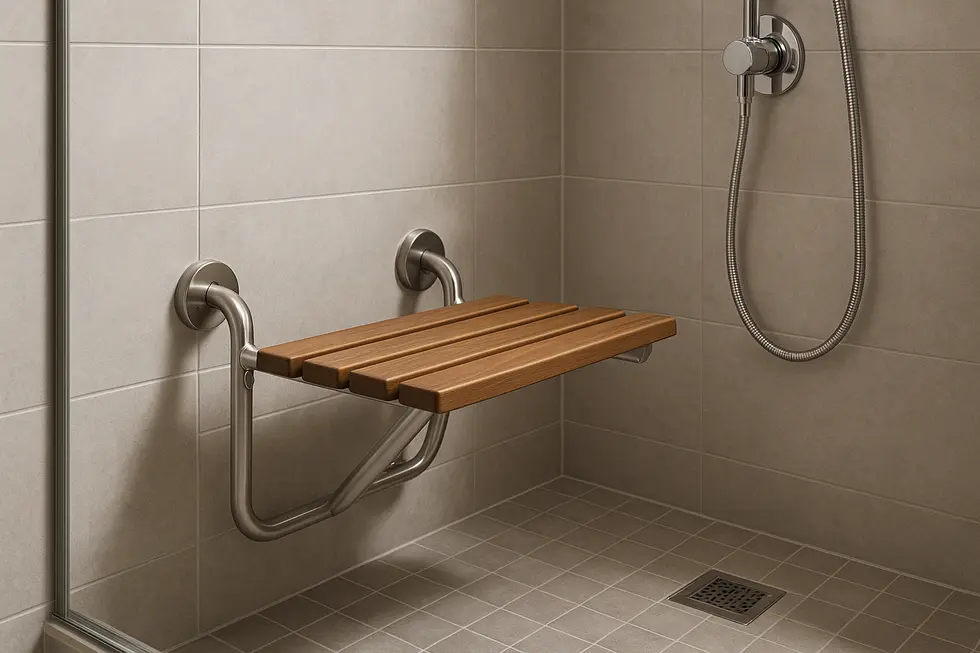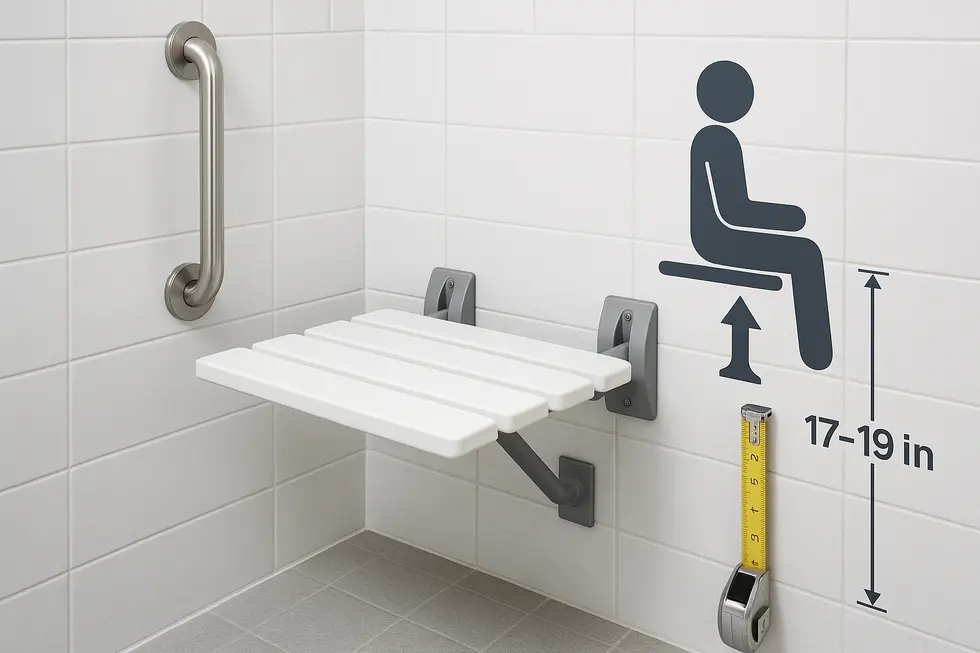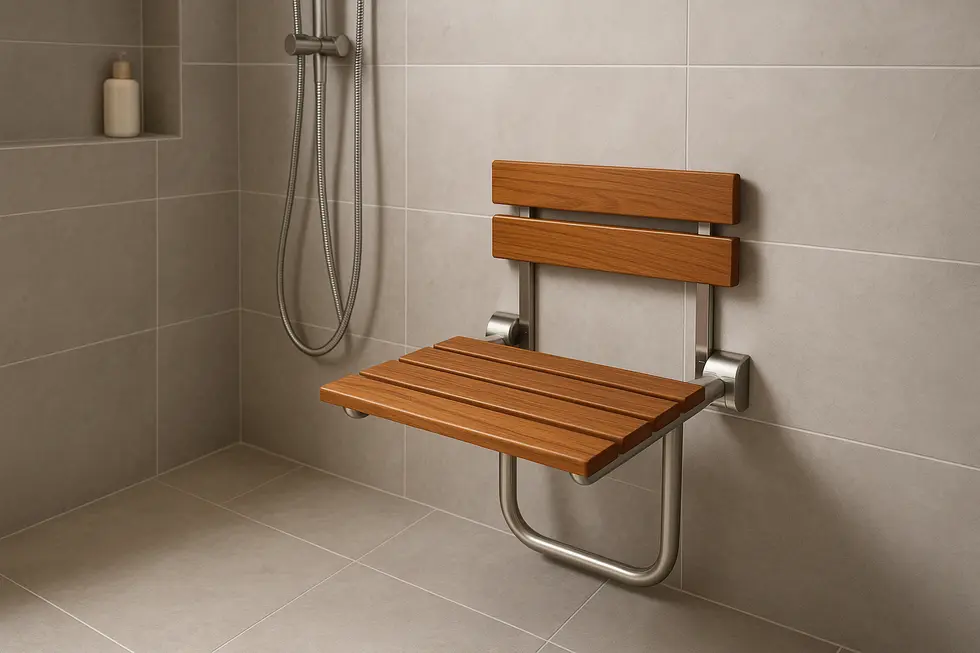Shower Seat
Enhancing Home Safety: Wall-Mounted Shower Seats for Disabled Individuals
Transform your bathroom into a safe and accessible space with wall-mounted shower seats specifically designed for disabled individuals. These seats are not only practical but also chic, providing essential support and comfort without compromising on style. From understanding their design and material intricacies to diving into the compliance standards and global market insights, this guide will empower families to make informed choices for enhancing bathroom safety and accessibility.
From Frame to Finish: Engineering Materials that Make Wall-Mounted Shower Seats Safe for Disabled Users

Strength begins behind the tile. A reliable wall mounted shower seat for disabled users must first survive the transfer of body weight through a slender hinge into the wall studs. Current accessibility codes require a minimum static capacity of 250 lb, yet modern engineering practice pushes well beyond that baseline. A conservative target of 400 lb allows for generous safety factors and future-proofs the wall mounted shower seat for disabled individuals who may be larger or experience dynamic loads when lowering themselves abruptly. Achieving that figure starts with a mounting bar that spans standard 16-inch stud centres and a frame of 6063-T6 aluminium or type 304 stainless steel, each offering outstanding yield strength and excellent corrosion resistance in steamy environments.
Surfaces that touch the skin carry a dual mandate: comfort and hygiene. High-density polyethylene feels warm, resists mould, and shrugs off bleach, while phenolic compact laminate brings a fire rating of Class A and an ultra-smooth antibacterial finish. Both materials are CNC-routed with 6–10 mm drainage gaps so water disappears instantly, keeping the sitter stable instead of slippery. Edges receive a 3 mm radius to prevent pressure points on the backs of legs, and slats are angled three degrees toward the wall so stray drips don’t track onto clothing or assistive devices.
Hidden details matter just as much. Self-lubricating acetal bushings eliminate metal-on-metal squeaks and prolong the 20,000-cycle operating life, while type 316 stainless fasteners resist chemical attack from shampoos and cleaning agents. Powder-coat or anodised finishes seal aluminium extrusions, surviving 1,000 hours of salt-spray testing with less than five percent surface rust. Even the fold-up profile is considered: kept below three inches so ambulant users can manoeuvre wheelchairs or shower commodes unimpeded. Every detail reflects what users expect from a wall mounted shower seat for disabled – strength, hygiene, and long-term reliability.
Installation protocols close the loop between clever design and real-world safety. Contractors are instructed to sink 3/8-inch stainless lag screws at least 57 mm into solid blocking, apply silicone sealant around every penetration, then proof-load the seat with 250 lb for five minutes before handover. Quarterly torque checks and a decade-interval bushing swap extend the service life to fifteen years in commercial settings—often longer at home.
For additional field guidance, this concise walkthrough of a folding wall-mounted shower seat offers practical tips on positioning and user ergonomics, while an external engineering spec illustrates the rigorous testing behind these numbers (see: technical example).
Strength, Height, and Peace of Mind: Understanding ADA Load Requirements for Wall-Mounted Shower Seats

A shower seat only fulfils its promise of independence when it can reliably hold the user’s weight at the exact height that makes transfers simple. The Americans with Disabilities Act distils this reality into two core numbers. First is height: the top of the seat must sit 17–19 inches above the finished floor. This band aligns the sitting surface with most wheelchairs, reducing the effort needed to slide across and helping carers avoid awkward lifts.
The second number is weight. ADA demands a minimum 250-pound load, yet leading clinical guidance encourages aiming higher because dynamic forces—such as lowering oneself quickly or shifting to reach the hand-held shower—easily amplify static weight. Many contemporary stainless-steel frames now carry 500 pounds; heavy-duty variants register test loads surpassing 800 pounds when fixed to reinforced blocking. Choosing a rating well above the user’s body weight, plus any potential medical equipment, creates a generous safety margin and prolongs product life.
Construction materials drive these figures. Type 304 stainless resists corrosion and flexing, while phenolic or teak slats disperse water and stay comfortable to skin. Rounded front edges protect fragile skin, and small gaps between slats drain water to curb slipping. Whatever the material, none of the published load capacities matter unless the seat is anchored correctly. Tile and drywall alone will fail; a solid masonry wall or 2″ × 10″ lumber backing is essential. Detailed blocking diagrams can be found in this guide to proper installation techniques.
Operation also enters the compliance picture. ADA section 309.4 limits the force needed to fold or unfold a seat to roughly five pounds. Gas-spring or torsion hinges meet this by counterbalancing the panel, letting users with limited grip move the seat with one hand.
When shopping, verify that the specification sheet lists both the 17–19 inch mounting band and a tested capacity at least equal to the intended user plus a robust buffer. An example of such documentation can be reviewed in this external technical specification sheet: ADA-rated stainless shower seat details. Armed with these numbers and proper wall preparation, a wall-mounted seat becomes a dependable platform for safe, dignified bathing.
Rising Demand and Evolving Innovation: The Global Marketplace for Wall-Mounted Shower Seats

An unprecedented demographic shift is reshaping bathroom design across the globe. Longer life expectancy, a surge in age-related mobility issues, and heightened disability awareness have pushed wall-mounted shower seats from niche medical aids to mainstream fixtures. In mature markets, stricter building codes now require accessible features in new homes, hotels, and care facilities, turning compliance into a significant growth engine. Meanwhile, retrofit projects are thriving as homeowners seek to age in place safely and cost-effectively.
Economic incentives reinforce this momentum. Many governments subsidize home modifications, and insurers increasingly recognize fall prevention devices as long-term cost savers. As a result, demand is broadening beyond healthcare settings into private residences, a trend mirrored by the uptick in online searches for guidance on a safe, code-compliant installation—topics thoroughly explored in resources like the safety wall-mounted shower seat guide.
Innovation keeps pace with rising expectations. Manufacturers have shifted toward corrosion-resistant metal frames paired with moisture-proof composites or sustainably sourced hardwood slats, delivering products that look at home in spa-style bathrooms yet meet rigorous international load-bearing standards. Space-saving foldaway mechanisms, height adjustability, and textured non-slip surfaces now appear even on entry-level models. Some premium designs integrate gas-assist hinges so users with limited strength can deploy the seat with minimal effort, aligning with universal design principles and ADA operation codes.
Digital transformation also shapes the competitive landscape. Global e-commerce platforms allow consumers to compare specifications instantly, placing pressure on suppliers to publish certified weight ratings and independent test data. While buyers in high-income regions focus on aesthetics and advanced ergonomics, price sensitivity still tempers adoption in parts of Asia, Latin America, and Africa. Nonetheless, healthcare infrastructure investments—and the emergence of modular, lower-cost product lines—are narrowing that gap.
Looking forward, analysts forecast steady compound growth as smart-home ecosystems extend into the bathroom. Bluetooth-enabled sensors that alert caregivers to prolonged occupancy, or IoT modules that log usage for rehabilitation tracking, may soon transition from prototypes to everyday features. Combined with the inexorable rise of older populations, these advances position wall-mounted shower seats as a foundational element of accessible living worldwide. (Source: Best Buy Canada market overview: https://www.bestbuy.ca/en-ca/shop/health-fitness/shower-chairs-for-seniors)
Final thoughts
Investing in wall-mounted shower seats isn’t just about compliance; it’s about creating safe and elegant spaces. These seats, available in various styles and built to support significant weight, ensure accessibility for disabled individuals. Recognizing their growing market relevance assures that you’re making a wise, future-proof choice. Prioritize safety and aesthetics by integrating these essential features in your bathroom.
Experience a new standard of clean with PEGABidet—designed for comfort, safety, and independence. Join thousands who trust us to make personal care simple and dignified. Contact us contact@pegabidet.com
About us
PEGABidet is a brand owned by L.A NEXTGEN LLC, based in California. We design intuitive, hygienic, and accessible bathroom solutions that prioritize safety, dignity, and independence. Our mission is to make personal care effortless and empowering for people at every stage of life.

